The temperature coefficient of resistance is the parameter that shows the relationship between the variation of resistance with an increase in temperature. The resistance of the metal increases linearly with an increase in the temperature.
This property is important in understanding the relation between resistance and temperature across different materials.
Engineers often calculate it using the temperature coefficient of resistance formula, which also requires knowing the unit of temperature coefficient of resistance (per °C or per K).
Whether you’re comparing metals with positive coefficients or semiconductors with negative coefficients, knowing what is the relation between temperature and resistance is essential for accurate circuit design and performance prediction.
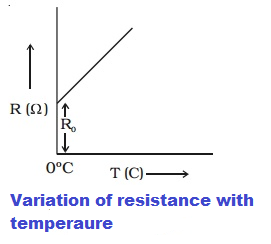
Definition of Temperature Coefficient of Resistance
The change in the resistance value with per degree change in the temperature is called the temperature coefficient of resistance(TCR).
Symbol of Temperature Coefficient of Resistance (α)
The temperature coefficient of resistance is represented by the Greek letter 𝝰 (Alpha).

This symbol is widely used in physics and electrical engineering to denote the rate at which the resistance of a material changes with temperature. The value of 𝝰 varies depending on the material and is typically given at a reference temperature, often 0°C or 20°C.
For example, metals usually have a positive 𝝰, meaning their resistance increases with temperature, whereas semiconductors and insulators often have a negative 𝝰, indicating a decrease in resistance as temperature rises.
Unit of Temperature Coefficient of Resistance
The unit of temperature coefficient of resistance(α) is per °C.
This means α expresses the fractional change in resistance per degree Celsius increase in temperature. It can also be expressed as per Kelvin (K⁻¹) since the size of one degree Celsius and one Kelvin are equal. This unit reflects how much the resistance changes relative to its original value for each degree rise in temperature.
Dimension of Temperature Coefficient of Resistance
The dimension of the temperature coefficient of resistance is the reciprocal of temperature, represented as [θ]⁻¹, where θ denotes temperature. This reflects that α measures how resistance changes per unit temperature change.
Applications and Importance of Temperature Coefficient of Resistance
The temperature coefficient of resistance (TCR) is vital for designing safe and efficient electrical and electronic systems.
It helps engineers predict resistance changes due to temperature, ensuring accuracy, stability, and safety in various applications:
- Electrical wiring in power systems – Selecting materials with suitable TCR avoids overheating under load.
- Precision measurement instruments – Low-TCR alloys like manganin ensure stable readings over temperature fluctuations.
- Temperature sensing – Positive TCR metals like platinum are used in RTDs for industrial temperature measurement.
- Semiconductor devices – Negative TCR materials help in temperature compensation of circuits.
Formula of Temperature Coefficient of Resistance
The resistance is R1 at temperature T1 degree centigrade and R2 at T2 degree Centigrade.

T0 is the temperature at zero-degree centigrade. The resistance at temperature ‘t’ can be given as ;
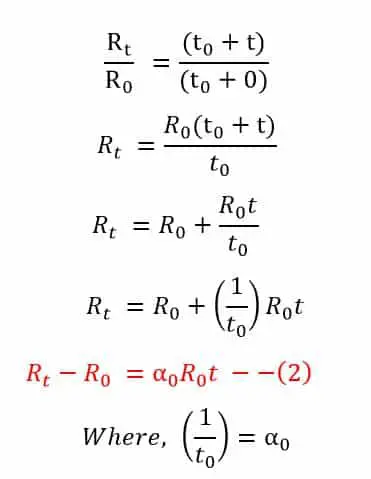
αo is called the temperature coefficient of the resistance of the material at 0°C. The formula for the temperature coefficient is given below.
![formula of temperature coefficient of resistance-alpha = (Rt - R0) / [R0 × (T2 - T1)]](https://www.electricalvolt.com/wp-content/uploads/2019/08/resistance4.jpg)
Relation between Temperature and Resistance
For metals, resistance increases with temperature; for semiconductors and insulators, resistance decreases with temperature.
The resistance at temperature t can be expressed as;
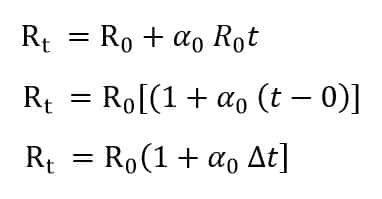
If the resistance of the material is R1 and R2 at temperatures t1 and t2 temperature.

The resistance of the material depends on the following;
1. The resistance of the substance at the initial temperature
2. The temperature coefficient of resistance-αo
3. The rise of temperature- Δt
Temperature Coefficient of Resistance of Various Materials
Metals like silver and copper have positive coefficients around 0.0038–0.0045 °C⁻¹, while materials like germanium have large negative coefficients.
The temperature coefficient of resistance of the substances at 20°c is as given below.
| S.No | Material | Symbol / Composition | Temperature Coefficient at 20°C (per °C) |
| 1 | Silver | Ag | 0.0038 |
| 2 | Copper | Cu | 0.00386 |
| 3 | Gold | Au | 0.0034 |
| 4 | Manganin | Cu = 84% + Mn = 12% + Ni = 4% | 0.000002 |
| 5 | Mercury | Hg | 0.0009 |
| 6 | Nichrome | Ni = 60% + Cr = 15% + Fe = 25% | 0.0004 |
| 7 | Tungsten | W | 0.0045 |
| 8 | Iron | Fe | 0.00651 |
| 9 | Aluminum | Al | 0.00429 |
| 10 | Platinum | Pt | 0.003927 |
| 11 | Constantan | Cu = 55% + Ni = 45% | 0.00003 |
| 12 | Germanium | Ge | -0.05 |
| 13 | Silicon | Si | -0.07 |
| 14 | Carbon | C | -0.0005 |
| 15 | Brass | Cu = 50–65% + Zn = 50–35% | 0.0015 |
| 16 | Manganese | Mn | 0.00001 |
| 17 | Tantalum | Ta | 0.0033 |
| 18 | Nickel | Ni | 0.00641 |
| 19 | Tin | Sn | 0.0042 |
| 20 | Zinc | Zn | 0.0037 |
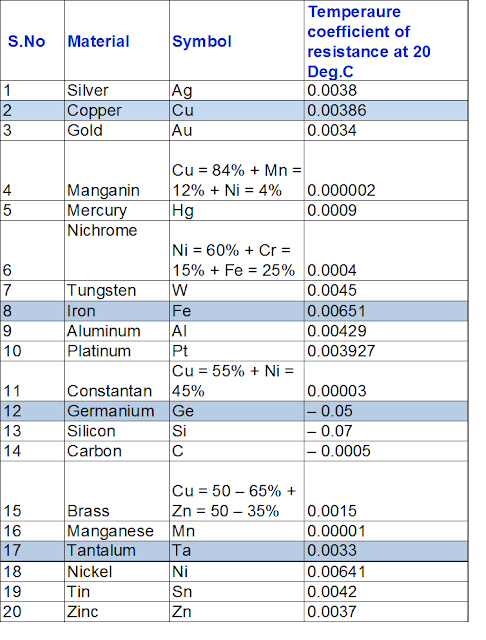
The temperature coefficient of the metals is positive, whereas the temperature coefficient of insulators and semiconductors is negative.
Why Does Resistance of Metallic Substances Increase with Temperature?
The metals have free electrons moving randomly in the crystal structure. With an increase in temperature, the random motion of free electrons and inter-atomic vibration increase, and as a result, the collision rate between electrons inside the metal increases.
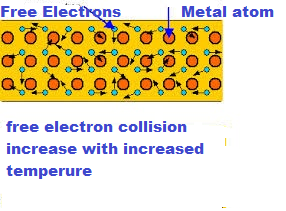
The increased collision rate impedes the flow of the electron through the metal, and thus, the resistance of the metal increases. Therefore, metals have poistive temperature coefficient(PTC).
In simple terms: For metals, when temperature ↑ → collisions ↑ → resistance ↑ → α (temperature coefficient) is positive.
Contrary to metallic substance, the resistance of the semiconductor and insulator substances decrease with an increase in temperature. The semiconductor and insulator material has a negative temperature coefficient.
Why Does Resistance of Non-Metallic Substances Decrease with Temperature?
With an increase in temperature, the heat energy in the crystal increases, and as a result, the covalent bonds start breaking and releasing more electrons in the crystal. Now, more electrons leave the valence band, pass through the forbidden gap, and reach the conduction band.
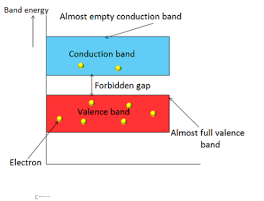
The number of free electrons reaching from the valence band to the conduction band increases with an increase in the temperature. Hence, the resistance of the non-metallic substance decreases with an increase in temperature. The semiconductors and insulators have negative temperature coefficient(NTC).
In short: For semiconductors & insulators, temperature ↑ → more charge carriers → resistance ↓ → α is negative.
Safety Considerations
- Incorrectly assuming the temperature coefficient can lead to overheating in conductors or devices.
- In high-current applications, rising resistance in metals with temperature can cause excess heat, insulation damage, or even fire hazards.
- For semiconductors, a drop in resistance at high temperatures can cause runaway currents if not properly limited.
- Always consider the worst-case operating temperature when designing electrical systems.
Factors Affecting Temperature Coefficient of Resistance
Several factors influence the temperature coefficient of resistance (TCR), and understanding them ensures accurate predictions of a material’s behavior:
- Material purity – Impurities can alter electron flow and affect TCR values.
- Mechanical strain or stress – Deformation in the conductor changes its resistance characteristics.
- Operating temperature range – TCR may vary at extreme low or high temperatures.
- Alloy composition – Different alloy percentages can significantly modify the TCR.
Experimental Method to Measure α
Required apparatus:
- Ohmmeter – to measure resistance.
- Heating element – to raise the temperature of the sample.
- Thermometer – to measure temperature accurately.
Step-by-step method:
- Measure the initial resistance (R₀) of the material at a known reference temperature T₀ (usually 20 °C).
- Gradually heat the material using the heating element.
- Measure the resistance R at a new temperature T.
- Record both temperature and resistance readings.
- Use the temperature coefficient formula: α=R−R0/R0(T−T0)
- Repeat the test for better accuracy and average the results.
Example calculation:
If R₀ = 100 Ω at 20 °C, and R = 108 Ω at 80 °C, then:
α=108−100/100×(80−20)
=8/6000
α=0.00133 per °C
Solved Problems on Temperature Coefficient of Resistance
Problem 1: The resistance of a bulb filament is 112Ω at a temperature of 110°C. and its resistance is 180Ω at 375 °C. Calculate its temperate coefficient.
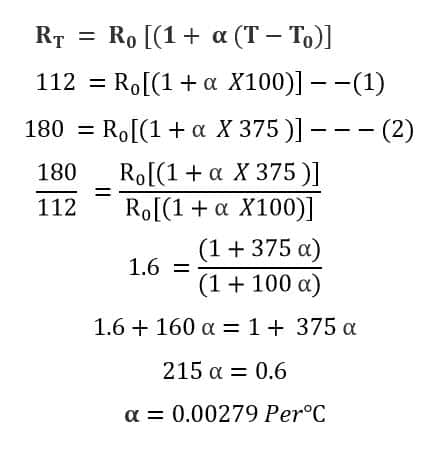
Prblem 2: The resistance of a bulb filament is 100Ω at a temperature of 100°C. If its TCR is 0.005 per °C, its resistance will become 200Ω at a temperature of?
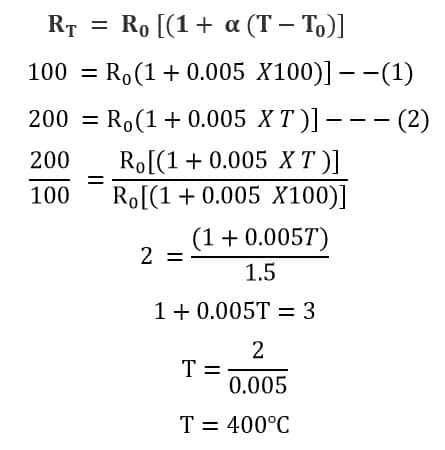
Limitations and Factors Affecting Measurement
While calculating the temperature coefficient of resistance (TCR), certain practical factors can introduce errors or affect accuracy:
- Contact resistance – Poor connections between measuring instruments and the material can skew readings.
- Temperature measurement errors – Inaccurate temperature readings lead to incorrect TCR values.
- Self-heating of the conductor – The measuring current itself can heat the conductor, altering resistance.
- Environmental conditions – Humidity, air flow, and ambient temperature stability affect results.
- Material impurities or defects – Variations in material composition change its resistance response.
Advantages and Limitations
Advantages:
- Predictable behavior of resistance with temperature.
- Useful for designing stable and reliable electronic circuits.
- Allows engineers to choose suitable materials for specific temperature ranges.
Limitations:
- The relationship between resistance and temperature is linear only over small temperature ranges.
- The temperature coefficient (α) can vary at different base temperatures.
- Environmental factors such as humidity and mechanical stress can affect accuracy.
Conclusion
The temperature coefficient of resistance is a key parameter for predicting how materials behave under temperature changes.
Understanding its value and sign helps engineers select suitable conductors, semiconductors, or insulators for specific applications, ensuring performance stability and safety in electrical systems.
Related Articles:
1 thought on “Temperature Coefficient of Resistance- Formula & Solved Problems”